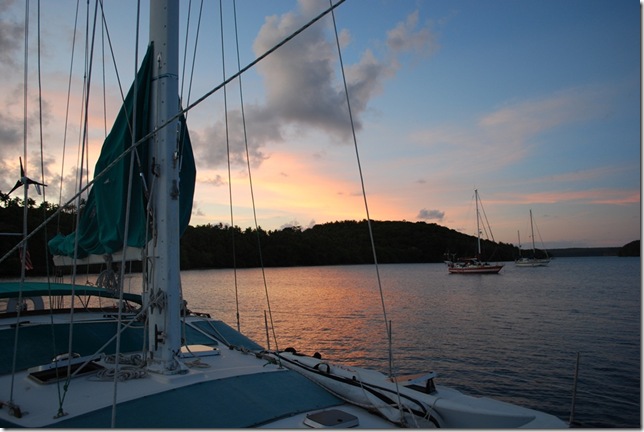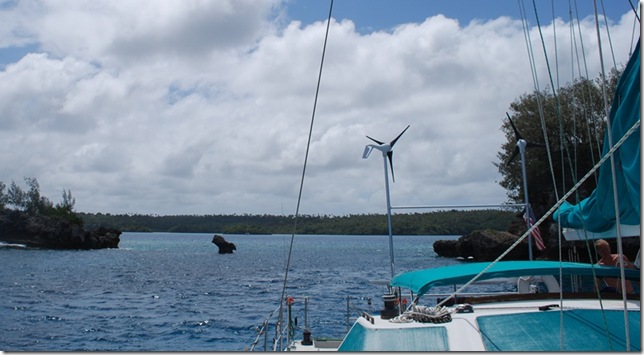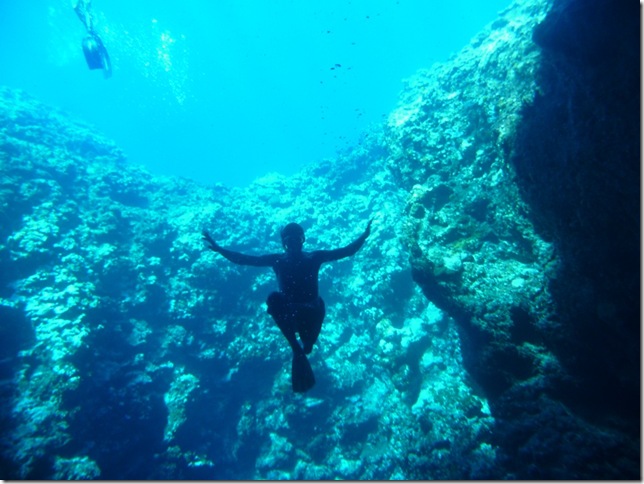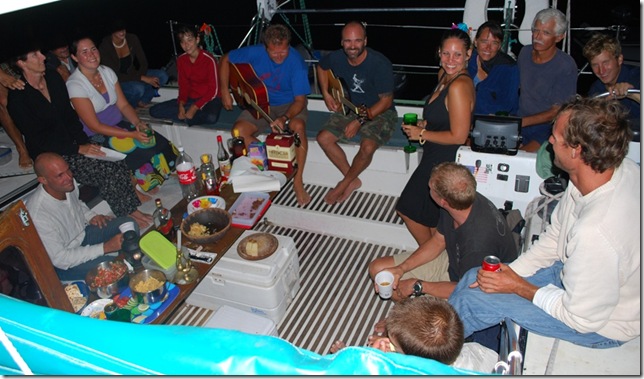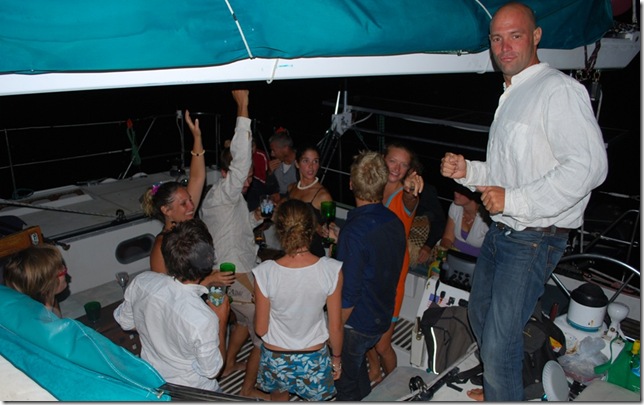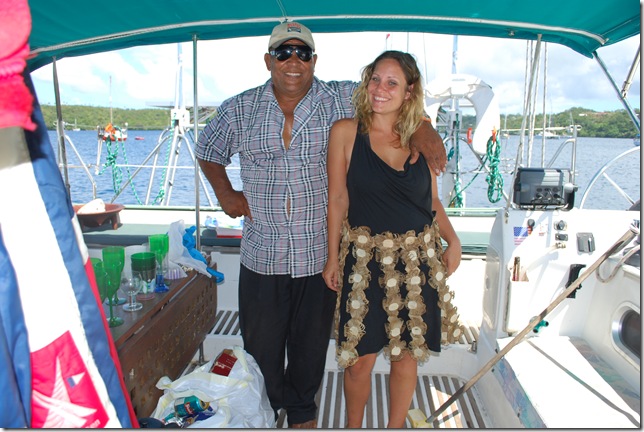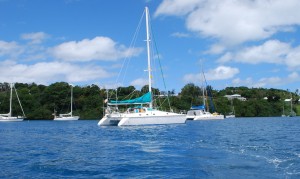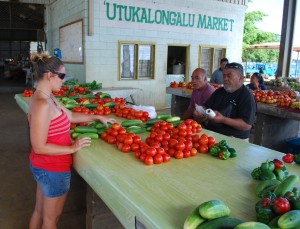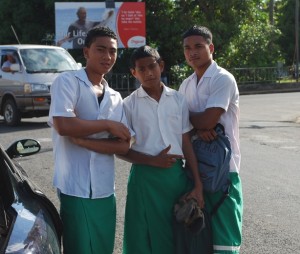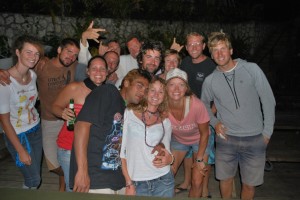Even though it’s a 2000+ nm detour for most circumnavigators, New Zealand is a popular cruising destination. In addition to providing a good place for boat repairs and offering natural and cultrual tourist attractions, it is almost completely out of the hurricane region of the South Pacific, making it a safe place to spend the hurricane season.
The passage there and back, however, has a bad reputation among sailors for being rough and potentially dangerous. When to make the passage and how to approach it is a common topic among cruisers this time of year. Although people who make the trip regularly or have a number of New Zealand passages under their belt seem to think it’s not too big of a deal, those of us who haven’t done it yet are all a little nervous. We’ve spent several months in the reasonably-predictable tradewinds and sailing to such a high latitude is always more uncertain.
The weather worries have a couple of sources. The first is that weather forecasts are usually only reliable for 3-5 days, after that, they’re much less accurate and anything over a week seems to be more like an educated guess. Most boats make 100-150 nm a day and the passage to New Zealand is about 1000-1200 nm. When heading southward, this means that you’re leaving the tradewinds and heading into the region of variable winds right around the time your departure weather forecast is getting stale, so can’t be sure what you’re going to get — calms, wind on the nose, a nice beam reach, or a SW gale. The timing of the passage is also a topic of discussion. The southern hemisphere seasons are changing from winter to summer. If you leave too early, you’re pretty much guaranteed a stong SW winter gale at some point. If you leave too late, you could be risking a hurriance either where you’re waiting to depart or possibly along the way. Hurricanes in November are rare, but they do happen, especially in El Nino years (this is currently a weak El Nino period). Winter storms are a guarantee in October, and summer weather starts to really settle in during December. Although the conditions may be uncomfortable, they’re generally not unsafe, although there have been a few occasions when boats on passage to or from New Zealand were hit with very strong, unpredicted winds from a quick-forming tropical storm or a “squash zone” (compresed isobars and high winds between nearby low and high pressure zones).
Advice based on absolutely avoiding hurricanes says to leave by the beginning of November, but the experienced sailors we’ve talked to say that the better passages are made later, sometimes well into December, albeit with some hurricane risk. It’s tempting to stay in beautiful and comfortable Vava’u, but we’re sticking with our original plan of leaving during the first week of November. Our plan, like that of many others we’ve spoken to, is to use modern communications and weather forecasting to our advantage. We’ll try to time our departure for a weather window that looks good, but we’ll also be updating our forecast information along the way. If it looks like a gale is coming to the area north of New Zealand, we’ll drift, heave-to, or set our sea anchor for a couple of days and let it pass in front of us before continuing. We’re also carrying plenty of fuel, changing the engine oil before leaving, and we’ll be much more ready to motor if the winds are light or contrary. We have roughly an 800 nm range under power, although hopefully we don’t have to motor anywhere near that much.
The weather forecast for the next week shows lots of wind on the nose south of the tradewinds — weak winds from a high and then strong SW winds as a low moves through. We’re hoping that next week looks better.
Wednesday morning we took a short dinghy ride over to the beach at the northern tip of Vakaeitu so that we could explore the reef that runs between Vakaeitu and Nuapapu. We spent an hour or so swimming out to Nuapapu and back along the reef, amazed the whole way. It is by far the most alive and colorful reef we’ve seen, with the hard coral spread out below us in a dazzling array of textures, shapes, and colors. Almost every color imaginable was present, with many types of coral showing multiple colors when we dove down to have a closer look. My favorite was probably a deep but bright blue, almost indigo colored coral that looked like antlers growing out from the reef. When you dove closer to it, you could see the “antlers” were covered in small spherical features. There weren’t a lot of fish, but the ones that we did see were pretty colorful. We saw a lot of familiar species, and a couple of new ones. One funny-looking type was colorful with a long snout that looked sort of like an anteater’s nose.
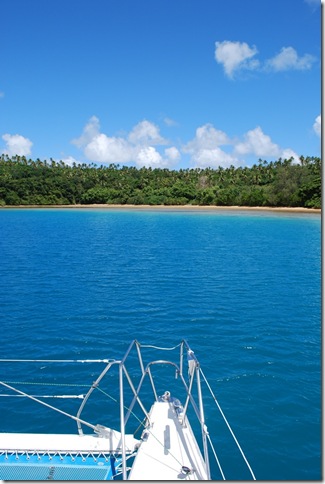 The beach at the bight of Vakaeitu
The beach at the bight of Vakaeitu
I spent the afternoon on a long-delayed project — the port head. It’s an electric one and has gradually gotten to the point that it was almost unusable. Eventually the blockage was found in the tapered plastic elbow at the head itself (of course I started looking at the other end). The 1 1/2″ pipe was clogged by build-up down to about 1/4″. Quite a messy afternoon, but the good news is that instead of having an expensive or tedious pump problem to deal with, we now have “turbo-head” back. You are your own plumber out here. I also fixed one of the forward bimini mounts, which had been pulled loose by an enthusiastic but not so sure-footed dancer on Sunday night.
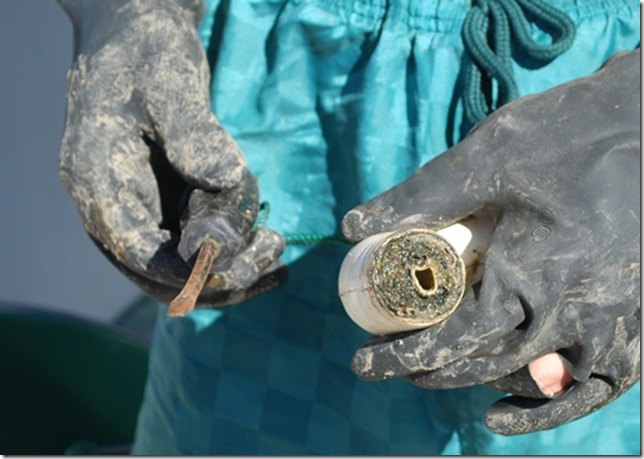 Just another day in paradise, eh?
Just another day in paradise, eh?
A good part of the appeal of Vava’u for sailors is the large number of small islands and reefs all clustered together. In addition to being beautiful and providing many quiet spots to anchor, the sailing within the group is often very pleasant, with nice tradewinds and calm, protected waters. You can easily sail anywhere within the group during the day, and moving anchorages often only takes a few hours.
 A typical scene, three boats under sail in the protected waters of the Vava’u group
A typical scene, three boats under sail in the protected waters of the Vava’u group
Thursday morning we headed for the southwest tip of Vakaeitu, where the boat anchored beside us had told us we could find some great coral walls for a scuba dive. Lauren and I spent about 45 minutes exploring the coral-covered walls. The coral was very similar to the day before, but with tanks we had time to explore it up-close and a a very leisurely pace. The terrain was incredible. Lauren described it as a fantasy-land, a combination of steep cliffs and rolling hills covered in many colors of healthy hard coral.
After our dive, we tried out anchorage #13, a sort of lagoon in the island of Hunga. A front was crossing Tonga, so the weather was windy and cloudy on the way, but luckily there was no rain. You enter into the Hunga lagoon through a narrow pass between two cliffs with a large rock near the middle of the channel that makes it not more than 50 feet wide. Inside, the water is mostly deep, but there are some shallower spots for anchoring near the edges and near two small islands in the middle of the lagoon. It’s another pretty spot, a deep-water lagoon surrounded by small mountains, cliffs, and beaches. The other nice feature of #13 was that S/V Anima was moored around the corner, so we were able to fit in some band practice with Martin on Thursday night.
The next morning, the sky had cleared with the passing front, but the winds remained and we set off to sail mostly into the wind to try out the anchorage at “Lisa’s Beach” (#10). We had planned a snorkeling stop on the way, but with the wind and occasionally overcast skies, we decided not to stop. I had started the trip under power, and was feeling a little tired and lazy, so I hadn’t set any sails, especially since the majority of the trip was right into the wind. I asked Lauren to stand watch for a while so I could catch a short nap, and the next thing I knew, she had killed the engine, unfurled the jib, and was doing a beautiful job of tacking eastward between the small islands and rocks. I was impressed. I guess I’ve been reduced to taking naps and fixing the head, which is a good deal overall.
Lisa’s Beach is a quiet, protected cove, and aside from a mega-yacht around the corner, we had the place to ourselves. We took advantage of the few hours of daylight we had left to go ashore and explore a bit. Large sections of the interior of the island are devoted to agriculture — we saw coconuts, taro, bananas, papaya, kava, and cows. It appears that the farming is done by hand, as we saw several men working in the small fields and one walking home with a machete and pitchfork. That would make for a long, tiring day.
Everywhere we’ve gone, the people have been friendly, and the woman living in the small house in the cove here came out to chat with us when we beached the dinghy. There’s a cliff right behind the house, and they have to walk a fair distance up the cliff on a concrete stairway before reaching the top where they could park a car. Her husband wasn’t home, but she invited us to a barbeque he was planning that night with a friend. We didn’t return until after dark, and it looked like the barbeque was scratched, but she still came out to say hello again and see if we were staying long enough to eat with them another night. We would probably join them if the four of us didn’t already have plans to attend a traditional Tongan feast tonight at anchorage #11.
If the weather cooperates, it looks like we’ll be here through Monday, when we’ll head south for Nuku’alofa with a possible stop in the Haapi group.
Neiafu harbor is one of the congregating places for cruising boats in the South Pacific (Marina Taina in Tahiti and Bora Bora are the other two we’ve seen). With all the boats moored and anchored in the harbor as well as the nearby anchorages, channel 16 is constantly crackling with boats hailing each other. All of the waterfront businesses standby on 16 as well. Old friends meet up again and new friends are made. You can map out the social networks just by listening to channel 16 — “Paje, Paje, this is Beduina”; Matajusi, Matajusi, Paje”; “Avel Mad, Avel Mad, Migration”; “Anima, Anima, Pura Vida”; and so on from the early morning until late at night. Good friends, good restaurants, friendly locals, free internet, good weather, safe and comfortable moorings, and reasonable prices, combine to make the days disappear.
Tonga itself is an interesting country. It’s a monarchy, and the king is no figurehead. Even though there is a prime minister, cabinet, and elected legislature, he has absolute power. Tongans are proud of being the only country in the Pacific that was never colonized and essentially remained independent from the time of the first European explorers to the present. After several ill-fated attempts, missionaries finally met with success in Tonga and converted the royal family. Tonga was just starting to establish is western-style government at the time, and things change slowly here, so the influence of the 19th century missionaries is still pretty apparent in this traditional, hierarchical society. On Sundays, radio stations may only play religious music, fishing and swimming are banned, and most businesses are closed. On any day of the week, there is a fine if men appear in public without a shirt, and nearly all Tongans swim fully clothed (shorts and shirt). It’s a bit unusual for Westerners, and especially cruisers. With nice weather most of the time and no one around for miles the two main reasons for wearing clothes are gone. Add to that doing laundry by hand, and many cruisers we’ve met return from passages or isolated anchorages with very little dirty laundry.
Sunday afternoon, we joined a group of about 11 cruisers aboard Anima III to visit Mariner’s Cave. The cave is on the steep north shore of Nuapapu and is entered from the sea by free diving down to about 8 feet then swimming 15 feet or so into the cave, where you can surface. We all went together for fun, and because the water is too deep to anchor, so someone has to stay aboard a drifting boat while others go into the cave. There’s a 3-page story in the cruising guide by a woman who lived in Vava’u 26 years before getting up the courage to go in, complete with the story of a copra ship officer who was killed when he surfaced too early and opened up his head on the rocks, but I think it’s just there to give you a bigger sense of accomplishment once you’ve done it. As they say, if you can dive a couple of yards away from the side of a sailboat, swim under the keel, and surface a couple of yards away on the other side, you’ll have no problem entering the cave. The difference is that you know how wide the boat is and that there’s open water on the other side. Your air seems to go pretty quickly when you’re swimming in as fast as you can and constantly searching for the point where the surface is no longer rock, but everybody made it with no problems. It was an overcast day, and after Bubble Cave in Niue, the interior didn’t seem incredibly impressive, but it was a nice cavern with a large entrance. After we had been in for a little bit, something really cool happened. As we were treading water, a swell came in, raising the water level in the cave. Because the cracks to the outside air above are relatively limited, the air pressure increased as the wave entered. As we cleared our ears to adjust, we were enveloped by a fog. With the air in the cave being saturated with water vapor, the small increase in pressure with an entering wave is enough to cause the vapor to condense and form fog. As the wave ran out and the water level fell, the fog dissipated. This happened several times before we finally dove out of the cave and returned to Anima for the short sail back into Neiafu harbor. Thanks to one of our fellow cruisers for the two pics below.
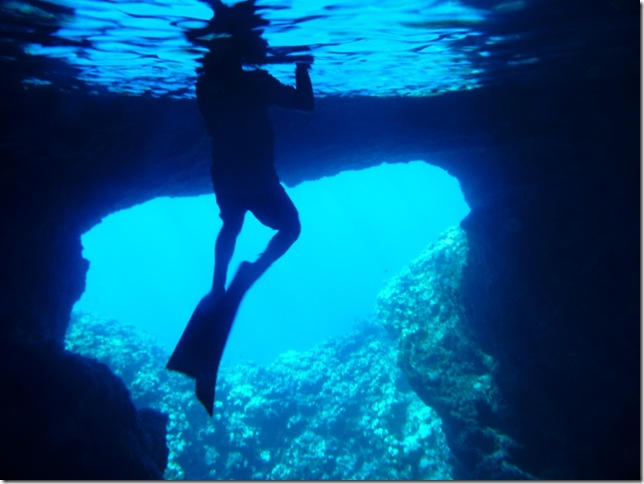 View from inside the cave looking out through the underwater entrance
View from inside the cave looking out through the underwater entrance
Tiffany’s birthday party on Sunday night was a big hit, as Tiff and everyone else seemed to have great time. We ended up with 26 people, and between the large cockpit and adjoining salon, there was enough space for most people to sit and graze on the nice spread of food. After we consumed a little “liquid courage”, it was time to sing. That afternoon we had joined up with Martin and Hans to rewrite the pop song “Breakfast at Tiffany’s” to fit with the theme of “Birthday for Tiffany”, and Lauren recruited a couple of other cruisers at the party to join her in singing the song to Tiff while Martin and Hans accompanied on their guitars. After that, members of the larger group took turns singing the traditional “Happy Birthday” songs in their respective languages (French, German, Swedish, French Canadian, and a Russian dialect). Incidentally, the French and Germans use the same tune that we do, while the others have totally unique songs. We sang a few Beatles songs after that, and 13-year-old Lisa from S/V Anyway impressed us all with her repertoire. She knew all the words, and her father explained that it was important to him to expose her to the classics. Once the crowd thinned out, it was time to dance. We had had a great time putting together a playlist of dance music earlier that morning, and several of the guests our age were familiar with the songs. They must have been enjoying themselves, as several of them stayed until 5 a.m.! We were surprised that all of the food managed to be eaten but then realized that it was a 10 hour party!
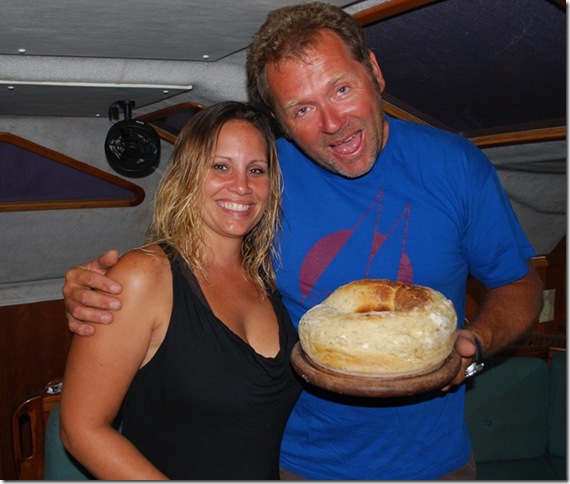 The birthday girl and Martin with his garlic bread
The birthday girl and Martin with his garlic bread
As you can imagine, Monday was a slow day, although we did manage to wake up at 8:30, when our overnight guests roused themselves to make the dinghy ride back to their boat. Not too long afterward, a local man rowing a small boat approached our stern and prepared to board. I said hello, then Tiffany went over to talk to him and help him tie up. I assumed they’d met ashore, but they hadn’t. He was looking for a cup of coffee, and we had some almost ready, so he soon had a cup. I asked what we could do for him, and is halting English he responded, “Mickey, I come from Pangiamotu,” and pointed to the large island at the south end of the harbor. OK, that didn’t help much, but he was friendly. It turns out he was selling handicrafts his wife had made. We were out of Tongan money, but he accepted New Zealand and US dollars, so we ended up with a bracelet and a Tongan courtesy flag.
After lunch with Martin at the Yacht Club (my first real omelet since Key West), some errands and a short nap, we managed to make it over to Disa for a going-away dinner for Anders, who’s returning to Sweden today. Anders had spent a year in Spain and treated us to a boat-style tapas dinner. Nick, a young single-hander (www.bigoceans.com), joined us and somehow we kept our eyes open swapping stories and laughing until 2am. Nick is one of several people we’ve met here who experienced the tsunami while in Samoa or Tonga, and their stories are really amazing.
After five days, we finally motored out of Neiafu toward anchorage #16 in the bight of Nuapapu. Not only did we want to explore the islands and reefs of Vava’u, we really needed some sleep. The Moorings (sailboat charter company) cruising guide for Vava’u is used by pretty much everybody, and it numbers all of the anchorages for convenience, which makes for odd conversations with everyone talking about going to 11 or 16 or having a nice time at 7, etc. For the record, #16 is very pretty with an incredible reef a short dingy ride away.
Vava’u, Tonga has been awesome so far, and we’ve only scratched the surface. We arrived on Thursday just before sunset and picked up a mooring in a field full of boats that included our friends on S/V Disa and S/V Anima. After getting situated, we caught up with the Disa crew and learned that we endured 50 knots of wind on the passage! Ever since our anemometer broke during our rough passage around the western cape of Cuba, we have just been estimating wind speed, and in some cases, it seems that we underestimate quite a bit. In fact, since our cat doesn’t heel at a ~60 degree angle in such winds (like Disa did), we were pretty comfortable down below. Unfortunately, Disa had their genoa sail tear into two pieces during the heavy winds, and we later discovered that our friends on S/V Avel Mad blew out their mainsail on the same passage. I’m glad we we were sailing with only half of the jib. It looks like the conservative approach paid off.
Friday we tied up to the dock to clear in with customs and immigration. It was a relatively easy process except that the health officer did not show, but we were cleared to go ashore anyway, just in time for lunch. Dallas and I first walked around talking to locals about the possibility of getting a propeller for our dinghy (no luck yet). In doing so, we found the Tongans to be extremely laid back and accommodating. Over our delicious and reasonably priced lunch of pizza and local beer, I read that Tonga is considered to be not only the land “where time begins” (as a result of its proximity to the international date line) but also “where time stands still.” While this may sound like the usual tourist spiel, it really fits with our experience of the local people, who do not seem at all hassled by tourists’ questions or anything else for that matter.
We continued walking and ran into the Disa crew at the market. Dallas went with Paul and Leo to the local hospital to track down the health officer and be done with the process of checking in. (Leo also went to have his ears checked out after free-diving too deep and having a problem similar to but worse than Dallas’.) Dallas reported that the hospital was very third world, with bathrooms smelling of urine. Immediately upon entering, the surgery room was visible, and at the time that they were there a woman was preparing to have a C-section. The lone doctor made an appearance 15 minutes later and checked out Leo’s ears before returning to the pregnant patient. Despite the conditions, Leo thought the health care was adequate and very cheap.
While they were at the hospital, I shopped for produce and handicrafts at the local market. There was a nice selection of fruits and vegetables, jewelry made of carved whale and ox bone, wooden carvings, woven baskets, and tapa. The vendors of the handicrafts were a bit competitive with one another and played the negotiation game (“I’ll give it to you for a special price…”.) Some people enjoy this, but I actually prefer to have an established price and take it or leave it.
I had a chance to observe the Tongan young people while waiting for the guys to return from the hospital. Being Friday afternoon, they still had on their school uniforms. Believe it or not, both the girls and boys wear skirts (tupenus). In addition, the girls all wear matching ribbons (particular colors seem to denote grade level), while the the boys wear woven mats around their waist, giving all of them a formal look. Unlike the U.S., it seemed that virtually all of youth were hanging out in small groups outdoors rather than chatting online or playing videogames at home.
Friday evening found us at the Mermaid Bar on the waterfront where we had a nice view of the weekly regatta. We enjoyed rooting on S/V Anima and chatting with other cruisers. A sizeable group of us walked over to Tonga Bar where we met and danced with locals to the mostly 80’s pop tunes. We didn’t want the fun to end, and almost the entire group of young cruisers participated in the 2 a.m. processional to the after-party that was held in a large building at the base of a hill a few blocks from the village center. We carried on dancing for another hour or so before piling in Martin’s dinghy to head back to our respective boats. Good times!
Tomorrow should be even better. Dallas and I are heading to nearby Mariner’s Cave for some snorkeling with Martin and friends in the afternoon, and tomorrow evening we will host the biggest party that we’ve had so far on Pura Vida to celebrate Tiff’s birthday! Vava’u seems to be the perfect place for the party, as many of the friends that we have met along the way are here.


